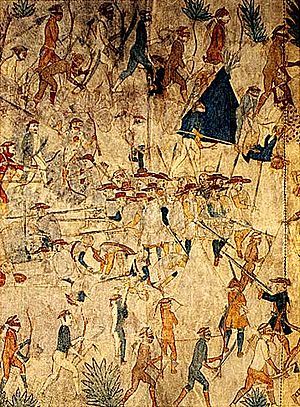Villasur expedition facts for kids
Quick facts for kids Villasur expedition |
|||||||
|---|---|---|---|---|---|---|---|
| Part of the War of the Quadruple Alliance | |||||||
 Villasur expedition painted on buffalo hide |
|||||||
|
|||||||
| Belligerents | |||||||
| Commanders and leaders | |||||||
| Unknown |
|
||||||
| Strength | |||||||
| Unknown | 117 | ||||||
| Casualties and losses | |||||||
| Unknown | 47 killed | ||||||
The Villasur expedition in 1720 was a journey by Spanish soldiers. They wanted to stop New France from gaining too much power in the Great Plains of North America. Lieutenant-General Pedro de Villasur led this group. But Pawnee and Otoe Native Americans attacked them in what is now Nebraska. Many soldiers and their allies died. The few who survived went back to New Mexico.
Contents
Why Did the Expedition Happen?
In the early 1700s, French explorers and fur traders started moving into the plains. These plains are west of the Missouri River. The French called this area Louisiana. In 1714, a French explorer named Étienne de Veniard, Sieur de Bourgmont reached the Platte River. Other French traders might have been there even earlier.
Spain had claimed the Great Plains since the 1500s. This was after the Coronado expedition. But Spain had not done much to control the area. Now, Spain worried about France's growing influence. In 1718, a big war called the War of the Quadruple Alliance began between France and Spain.
The Journey Begins
Antonio Valverde y Cosío was the governor of Nuevo México. His base was in Santa Fe. He told Villasur to find and capture French traders on the plains. Spanish leaders hoped to learn more about France's plans in the area.
Villasur had no experience dealing with Native American groups. But he left Santa Fe on June 16, 1720. His group included about 40 Spanish soldiers. These soldiers were called cuera or leather soldiers. They wore special leather armor.
Who Was in the Group?
The expedition also had 60 to 70 Pueblo allies. A priest and a Spanish trader joined them too. About 12 Apache guides came along. The Apache were enemies of the Pawnee. The scout leader, José Naranjo, was part African and part Hopi. He might have explored the South Platte River area before.
Traveling Through the Plains
The expedition traveled northeast. They went through areas that are now Colorado, Kansas, and Nebraska. In August, they met the Pawnee and Otoe people. This meeting happened near the Platte and Loup rivers.
Villasur tried to talk with the Native Americans. He used Francisco Sistaca, a Pawnee man who was enslaved, to translate. On August 13, Sistaca disappeared from the camp. Villasur camped that night south of where the Loup and Platte rivers meet. He was worried about an attack. The Pawnee and Otoe groups seemed to be growing in number and becoming more aggressive.
The Battle of the Platte River
The Pawnee and Otoe attacked at dawn on August 14. They fired many muskets and shot arrows. Then they charged into the fight. They wore only paint, headbands, moccasins, and short leggings.
Some people who survived said that Frenchmen were with the attackers. A painting of the battle shows men in European clothes. The Spanish soldiers were mostly asleep when the attack started. Maybe Sistaca had told the Pawnee the best time to attack.
What Happened During the Fight?
The battle was short. Thirty-six Spaniards were killed, including Villasur and Naranjo. Ten Pueblo scouts also died. Jean L'Archevêque, a Frenchman who was an interpreter for the Spanish, was also killed.
The Pueblo allies were camped nearby but separate from the Spanish. They were not the first ones attacked. Most of them managed to escape. The few Spanish soldiers who got away were those holding the horses. They were able to break free while their friends tried to form a defense.
What Happened After the Battle?
The Spanish and Pueblo survivors returned to Santa Fe on September 6. This expedition had traveled farther north and east than any other Spanish military group. Their defeat meant the end of Spanish influence in the central Great Plains.
For the next seven years, the governors of New Mexico investigated the disaster. They tried to figure out who was to blame. The French in Illinois were happy to hear about the battle in October. However, later French expeditions did not manage to set up strong trade and influence in the area either.
Images for kids
See also
 In Spanish: Expedición Villasur para niños
In Spanish: Expedición Villasur para niños


